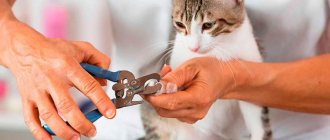Trimming a cat's nails is often stressful for everyone - both the cat and the trimmer. But this state of affairs is not at all necessary.
Every cat can be taught to tolerate and even enjoy nail trimming. By following a few simple tips, you and your cat can relax during your regular manicure routine.
Setting the Mood
In an ideal world, you would start training your cat to accept nail trims as a kitten, once they learn how the world works. No matter when you start, nail trimming should always be done in a quiet and peaceful place. Ideally, trim your cat's nails when they want to sleep, such as after eating.
Stay away from windows and other pets that might distract you or them. You can take your cat with you to a place where you can sit comfortably with her on your lap.
Why you shouldn't declaw your cat
Declawing surgery, or soft paw procedure, also known as onychectomy, is prohibited in some countries. It is considered animal cruelty and for good reason. This is an extremely painful and unnatural operation that should not be performed for the following reasons:
- extremely long and painful recovery period;
- the animal remains disabled for its entire life, since during onychectomy the terminal phalanx of the finger is removed along with the claw;
- high risk of complications (infection, suppuration, etc.) and subsequent death of the animal;
- the cat's behavior may change after surgery;
- the absence of claws impairs the cat’s sense of balance and mobility;
- ignoring the tray, because without claws a cat cannot fully rummage through the litter as before.
Make friends with paw
Some cats don't even like having their paws touched, let alone having their claws trimmed. Take the time to make them feel comfortable touching their paws and your efforts will pay off in the long run.
Gently pinch one paw between your fingers and rub gently for two to three seconds. If your cat moves during the process, watch her gesture carefully.
Then squeeze your paw so that one nail extends. Release immediately and give the cat a treat. If you can, do this two or three times a day until your cat gets used to it and doesn't resist as much.
How to prepare for the procedure
The owner must know how to prepare for pruning. Most pets initially resist pruning with all their might. It is important to properly prepare your animal. It is better to choose a time when he is relaxed and in a good mood. You need to start with a paw massage so that the pet does not feel discomfort. Attention switches to other activities and objects.
In the first months, the kitten experiences fear, fear and even irritation. It can break free and run away, and if held by force, it can even bite or scratch a person.
You should not use physical force, as it is necessary to convince your furry pet that this procedure is absolutely safe for him, that he has nothing to be afraid of. Trimming should be done regularly; the animal will gradually get used to it.
Over time, a habit will appear, and to make this happen faster, you can use encouragement in the form of something tasty. In order for pruning to be taken calmly, you should not expose your pet to stress. The owner should talk to him affectionately and stroke him. If the cat is too scared, it is better to postpone the procedure.
Introduce your cat to clippers
Unfamiliar objects can cause stress in a cat. Leave the nail clippers out for your cat to explore. You can even leave treats on them for your cat to sniff and become familiar with.
Some cats are afraid of the sound made by nail clippers. Place the cat on your lap and take the clippers. Bring the clippers to the paws and gently massage one paw, touch the paw with the clippers without cutting anything. Immediately reward your cat for taking it all in stride.
What to do if your cat won't let you cut her nails?
If the animal is not accustomed to grooming from a very early age, the very fact of “violence” can cause a very strong reaction. The cat begins to scream in a heart-rending voice, struggle, and scratch. What to do in such a situation?
The main thing to remember is that trimming an animal’s nails is painless. All his “performances” are connected, rather, with the fact itself: he is being held and some kind of manipulation is carried out against his will.
Try to calm your pet down and talk to him gently. Does not help? You can protect your hands from scratches by wrapping your pet in a large terry towel. One paw at a time is removed from the bag and the procedure is carried out as quickly and accurately as possible. This method is also good because you do not risk causing pain to the animal, which can happen if you hold it with your hands.
Another, “extreme” option is to give your pet ¼ tablet of suprastin. This antihistamine has a strong sedative effect. Within an hour, the cat will fall asleep or at least be very inhibited. It will not cause harm if you do not abuse it.
Attention. If the cat is small, it is better to take not even a quarter, but an eighth of the tablet, otherwise your pet will sleep for the whole day.
It's time to cut
Once you've trained your cat to use clippers, it's time to try clipping. Place the cat on your lap, facing away from you. Take one of your cat's paws in your hand and gently press down on the pad until you can clearly see its claw. If the claw needs trimming, cut off only the sharp end and avoid deep trimming.
After trimming the claw, immediately release your paw and reward your cat if she notices what you are doing. If your cat is relaxed and doesn't mind the clipping, move on to other nails.
Many cats will complain and meow after you trim two or three nails. If this happens, stop and let them go.
Always reward your cat after grooming with a treat or special toy. This will show your cat that grooming is stress-free and enjoyable. You may need a few short sessions to trim all the nails.
What if it doesn't work out?
It is possible that the cat will turn out to be too obstinate, and many days of efforts and tricks to accustom it to manicure will be in vain. In this case, contact a specialist at a veterinary clinic or grooming salon. But keep in mind that such visits can be stressful for a furry creature.
Think about what exactly you didn’t like about the cat’s claws? If the problem is solely in scratched furniture and wallpaper, purchase several scratching posts, saving your pet from negative emotions.
Never rush
If you look at your cat's claws, you will see a darker part inside a mostly clear, hard surface. This part is called the quick claw.
This is where the nerves and blood vessels are located. Never stop there, otherwise your cat may bleed and become uncomfortable.
If you've ever broken a nail, you know why cats don't like it. Instead, trim only the white part of the nail.
It's always better to leave a larger claw than to cut too deep. You may want to have a styptic or powder on hand.
You can use it to stop bleeding if you accidentally cut too deep. You can find these products at most pet stores.
How to trim a cat's claws correctly?
Cat owners often doubt whether it is possible to cut their cat's claws; they are afraid of hurting or harming their pet. Meanwhile, trimming a cat’s claws correctly at home is not at all difficult. Let's start with choosing a tool.
How to trim a cat’s claws is up to everyone to choose for themselves. Ordinary nail scissors, of course, will not work. But many have adapted to trim their pets’ claws with ordinary “human” nail clippers.
There are also special scissors: they have convenient grooves on the blades that prevent the claw from slipping.
Another special tool is a guillotine claw cutter. It is similar to wire cutters, only it has a closed ring into which the claw is threaded. Then just press the handles - and the blade cuts quickly and accurately.
There are several rules that should be followed when trimming your pet's claws:
- Less is better than more. The transparent part of the claw is trimmed; there are no blood vessels there.
- Unlike human ones, when trimming cat claws, the scissors are held vertically rather than horizontally.
- The cut line should be perpendicular to the nail line. You should not cut at an angle - jagged edges may appear.
Nail trim schedule
Most cats should have their nails trimmed every one and a half to two weeks. Getting into a routine will make it easier to keep your cat's claws under control. If you have trouble trimming nails, you can ask a groomer or veterinarian for advice.
The ASPCA strongly discourages cats from declawing. This can lead to permanent complications and pain. Instead, give your cat a place to scratch, talk to your veterinarian about nail covers, or trim their nails more regularly.
Haircutting tools
Professionals emphasize that the devices from a manicure set are not suitable for this. But they are being a little disingenuous if they say that if used carefully they will not cause harm. Professional clinics use special trimmers, but not everyone has this at home. Therefore, such devices are predominantly used.
Nail cutter - specialized scissors for trimming claws, made of steel.
Guillotine trimmer - ideal for beginners. When you press the handle, a special blade extends, which removes a certain section.
Nail clippers are also suitable for this task, but they need to be held at a certain angle, perpendicular to the nail. If you tilt them at a greater angle, the plates of the claw may begin to peel off, which will lead to injury.
Nail file - used to adjust the shape.
There is a certain limitation for this kind of devices; they must be rigid. Animals have much stronger claws than humans.
Before use, be sure to disinfect the instrument and wipe it with a special antiseptic solution or alcohol. It is also important to stock up on peroxide and cotton wool.
Why trim your cat's claws?
Long claws on a cat
Cats' claws grow throughout their lives, and in order to regulate their length, animals are forced to constantly grind them down. Yard cats and pets that their owners let outside solve the problem of overgrown claws by grinding them off on asphalt or trees .
And domestic cats have no choice but to sharpen their claws on wooden surfaces, walls and door frames. The result of such “hooliganism” is known to all owners of furry pets: torn wallpaper, hopelessly damaged upholstered furniture and traces of scratches on the doors of cabinets and bedside tables.
If there is no scratching post in the house, then torn wallpaper and sofas will not take long to appear!
Another argument in favor of this procedure is that claws that are too long can grow into the pads of the paws, causing pain when walking.
To protect furniture, curtains and wallpaper from the sharp claws of a pet, owners have two options - either purchase a scratching post or regularly trim the cat’s claws.
A scratching post can only partially solve the problem of a pet’s overgrown claws, because there is no absolute guarantee that the cat will sharpen its claws exclusively on it.











